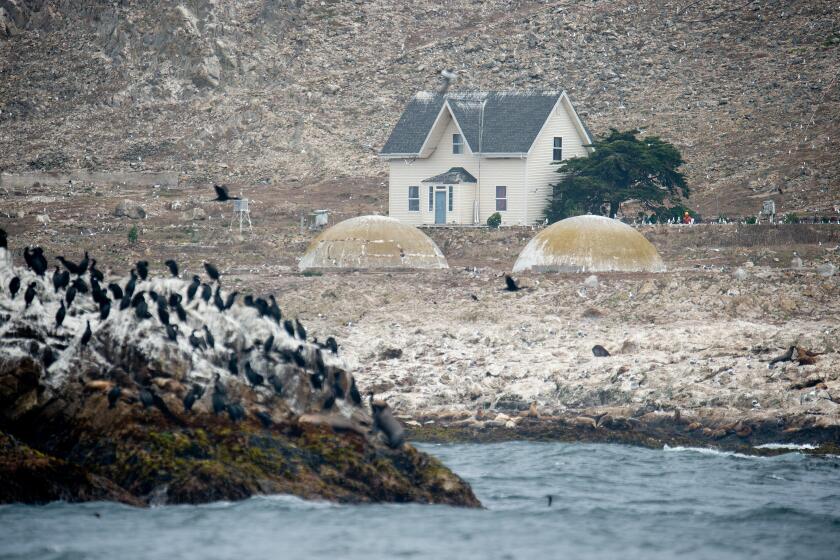Watch out, Farallon mice. Coastal Commission approves poison air drop

- Share via
The mice lost.
The birds won.
After years of scrumming and divisions among environmentalists over the fate of thousands of mice living on the Farallon Islands west of San Francisco, the California Coastal Commission voted 5-3 Thursday to allow the poisoning of the mice.
The U.S. Fish and Wildlife Service plans next fall to load helicopters with roughly 2,800 pounds of a highly toxic pesticide banned on land in California and dump the poison onto the mice.
Most of the reaction to my column on the matter earlier this week was one form or another of shock and horror.
“I have to say when I first began reading your article, I thought you must be kidding,” said reader Susie Harrison. “Who in their right mind would even think of such a thing as to drop poison on an island with the potential harm to wildlife, not to mention contamination of the soil.”
Harrison had what she considered a better solution.
“Have they ever heard of cats?”
In a hearing that lasted several hours Thursday, passionate testimony came from both sides, and that’s something that’s been happening for a decade as various options have been considered. People who care about the environment and wildlife respectfully disagree on this matter.
The issue, in brief, is that mice were introduced to the Farallon Islands more than a century ago by sailors. Their population rises and falls cyclically, reaching as high as 60,000 each year, and they voraciously attack plants and insects. They also attract burrowing owls who fly over from the mainland and snack not just on mice, but on the eggs of birds including the ashy storm-petrel, a candidate for the endangered species list.
There’s not much of a constituency for the mice, but interested parties differ on whether a potent poison will get into the food chain.
Richard Charter of the Ocean Foundation said the area around the Farallon Islands are “the most carefully protected coastal waters in the world,” and he argued that “we know better than to spread this poison in a sanctuary system.”
But conservationists armed with reports on the use of similar strategies on islands around the world extolled the virtues of eliminating invasive species such as mice to protect dwindling native life. In the Farallon plan, gulls and other birds would be “hazed” off the island before the pesticide drop so they don’t eat either the mice or the poison.
“The easiest way to conserve biodiversity worldwide is to protect the species on islands,” said Dr. Carolyn Kurle, a UC San Diego professor of conservation ecology who spoke on behalf of several colleagues she identified as experts on the negative impacts of invasive species on islands.
Lopez: The U.S. wants to air-drop poison on Farallon Islands mice. Not everybody hates the idea
The U.S. Fish and Wildlife Service wants to poison Farallon Islands mice. Foes say it’s not safe for environment
Hundreds of threatened species have benefited worldwide from invasive mammal removal, Kurle said, including six birds common on the Farallon Islands — among them the storm petrel, the tufted puffin and the Brandt’s cormorant.
Coastal Commissioner Roberto Uranga said he didn’t think enough alternative abatement possibilities had been considered, and Commissioner Carole Groom agreed with him, saying of the poison plan, “I don’t think it’s going to have a happy ending.” Both voted against.
Commission chair Donne Brownsey said she was conflicted but put her faith in the coastal agency’s insistence on safety protocols, as well as a demand for a water quality plan, and full monitoring of the program once it begins.
There will likely be some negative consequences from the poison drop, she said, “but we will have done our best to limit that, to monitor it, to ensure that if it does not go according to plan, it will stop.”
So after a decade of debate about how to get rid of the mice — a debate that has included conversations about feeding them contraceptives — is that the end of the story?
Not necessarily.
The Ocean Foundation’s Charter, who has worked for decades to help establish protected status for the Farallon Islands and other marine treasures, called the vote an “embarrassing day for the Coastal Commission.” He said it’s time for the Office of National Marine Sanctuaries to step in.
“This isn’t over by a long shot,” Charter said.
Privacy and surveillance update: In the matter regarding a plan by Rancho Palos Verdes homeowner associations to use cameras that would read the license plates of vehicles as a crime-watch tool, the Coastal Commission decided to intercede.
A permit request for the cameras was approved by the city of Rancho Palos Verdes, but the area is in the Coastal Zone and the Coastal Commission is exerting its permitting authority.
A hearing will be held in the new year.
steve.lopez@latimes.com
More to Read
Sign up for Essential California
The most important California stories and recommendations in your inbox every morning.
You may occasionally receive promotional content from the Los Angeles Times.















